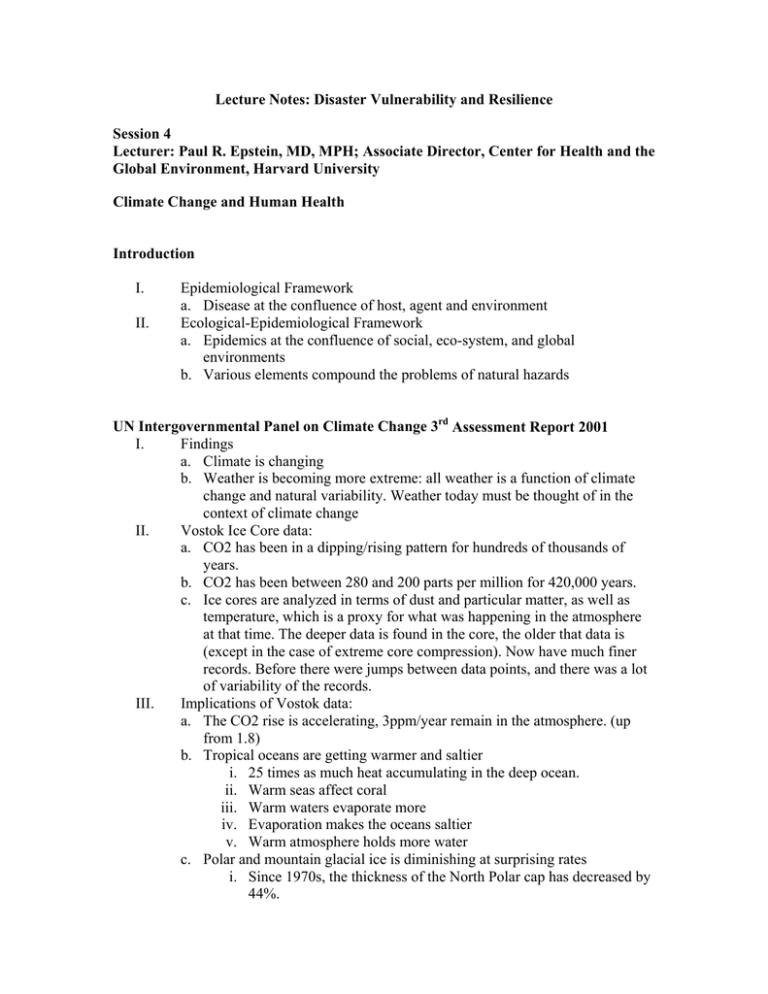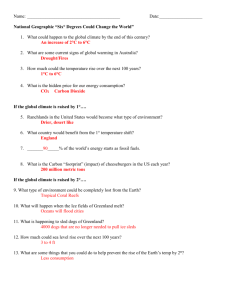Lecture Notes: Disaster Vulnerability and Resilience Session 4
advertisement

Lecture Notes: Disaster Vulnerability and Resilience Session 4 Lecturer: Paul R. Epstein, MD, MPH; Associate Director, Center for Health and the Global Environment, Harvard University Climate Change and Human Health Introduction I. II. Epidemiological Framework a. Disease at the confluence of host, agent and environment Ecological-Epidemiological Framework a. Epidemics at the confluence of social, eco-system, and global environments b. Various elements compound the problems of natural hazards UN Intergovernmental Panel on Climate Change 3rd Assessment Report 2001 I. Findings a. Climate is changing b. Weather is becoming more extreme: all weather is a function of climate change and natural variability. Weather today must be thought of in the context of climate change II. Vostok Ice Core data: a. CO2 has been in a dipping/rising pattern for hundreds of thousands of years. b. CO2 has been between 280 and 200 parts per million for 420,000 years. c. Ice cores are analyzed in terms of dust and particular matter, as well as temperature, which is a proxy for what was happening in the atmosphere at that time. The deeper data is found in the core, the older that data is (except in the case of extreme core compression). Now have much finer records. Before there were jumps between data points, and there was a lot of variability of the records. III. Implications of Vostok data: a. The CO2 rise is accelerating, 3ppm/year remain in the atmosphere. (up from 1.8) b. Tropical oceans are getting warmer and saltier i. 25 times as much heat accumulating in the deep ocean. ii. Warm seas affect coral iii. Warm waters evaporate more iv. Evaporation makes the oceans saltier v. Warm atmosphere holds more water c. Polar and mountain glacial ice is diminishing at surprising rates i. Since 1970s, the thickness of the North Polar cap has decreased by 44%. ii. iii. iv. v. IV. V. Greenland is melting at very high rates Ice-melting setting up for instability of Greenland ice. Unstable systems can be restabilized Seeing more record hot and record cold weather, more rain and more drought d. Winds around both poles are becoming more forceful. e. United States is not admitting that climate change is occurring Model Projections: a. By 2020, 2050, we will see double, triple inner city mortality. i. Surprises: more and more outlier events (2003, Europe: 10 degrees C > 30 year average; India . T 122 degrees F, 1400 deaths) ii. 21,000-35,000 deaths direct cardio-vascular health related. b. Asthma has increased 2-3 times since 1980s i. Floods and Fungi ii. Droughts and Fires iii. Ground-level Ozone and Heat Waves iv. Pollen and CO2 1. Ragweed Pollen Production increases significantly with increases in CO2 ppm (2x ppm, 60% increase in pollen production). 2. Greatly increased pollen counts in Spring, Summer, and Fall c. Inner city problem: heat island, CO2 dome. 1. Improving city environments could reduce CO2 emissions Data Analysis: i. The ICC has examined climate change over numerous timescales, patterns, etc. But for the last 100 years, natural variability only explains part of the data, combined with human factors becomes a good fit for the data. Emerging Infectious Diseases I. Insurgence of new diseases a. 30 diseases “new” to medicine since 1976 i. whether they are new actually or not, is undetermined (they are just recently emerging as human epidemics) ii. Transfer of diseases from animals to humans is something seen 10,000 years ago when agriculture was beginning, glaciers retreating. b. Resurgence of old diseases i. Vectors (mosquitoes, ticks, rodents, etc.) respond to environmental conditions, ii. Water-borne diseases are affected by climate change c. Infectious diseases come in waves, epidemiology, mapping leads to important interventions. II. Montane Regions: a. b. c. d. III. IV. Plant migrations Glacial retreat, acceleration Vector-Borne Disease shifts Average Tropical Freezing Level has moved up about 450 feet. El Nino events correspond with vector-borne disease shifts. i. Climate affects the range ii. Weather affects the timing and effect of the outbreak Extreme Weather Events and Disease Clusters a. El Nino/La Nina i. Places affected by El Nino events are also affected by vector-borne diseases: correlation between disease and areas affected by abnormally wet or abnormally dry areas. ii. El Nino events are often followed by La Nina events. b. Precipitation Extremes i. Past century avg annual precipitation increase of 7% ii. Heavy rain events increased 14% iii. Very heavy rain events increased 20% iv. Western drought: worst in 500 years; devastating rains 2005. v. In the 20th century, we can only understand the patterns if we account for greenhouse gases. c. Hurricane Mitch: Disease Clusters: i. Mosquito born disease ii. Water-borne disease iii. Rodent-borne disease d. Natural disasters i. Rise in number ii. Rise in types of events e. West Nile Virus i. Related to drought in the inner city ii. Disease of wildlife: 1. 230 species animals 2. 138 species birds 3. Ecological ripples: a. Diseases can be forces of global change b. Extinction c. Predator/prey relation instability Weather Anomalies, Travel Hazards and Trauma a. More severe winters in Northeast US and Europe b. Soybean rust (fungal disease in U.S., China, Brazil) expanding across the united states (major economic, food security threat). Flood fosters fungi, warm weather allows it to travel. c. Forest Fires i. Host: Spruce Trees dries ii. Pests: Bark Beetles boosted with warming iii. Fires denude large swaths of land. Crops and forest habitats are in danger. VI. b. Coral Bleaching (Warming and Microbes) i. Habitat changes are affecting coral ii. Warming allows more microbe growth. Costs of Emerging Infectious Diseases: a. Affects trade, travel, tourism, business b. Insurance/Reinsurance industry is concerned i. Long-term vision ii. 1980s: Weather-related events $4 billion/year iii. 1990s: $40 billion/year iv. Starting to see real threat of this instability, weighing in with lobbying in Washington, DC. Moving Forward I. Harmonizing Adaptation with Mitigation a. Need to meet basic needs with clean energy sources i. Clinics ii. Homes iii. Schools iv. Computers v. Cooking b. Water: i. Purification ii. Pumping iii. Irrigation iv. Desalinization II. Bring together Regulation, Fund/Subsidies/Tax Incentives, and Institutional Power to meet these goals: a. Energy Efficiency b. Green Buildings/Smart Growth c. Rationalized Transport and Transit d. Retrofitting Infrastructure e. Ecological Reconstruction








